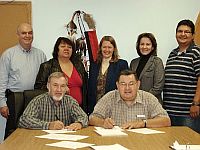 Decades ago, when the Wilroy and Geco Mines went into operation in Manitouwadge and in 1985, when the Hemlo gold camp went into production on the outskirts of Marathon, no one thought to sit down and talk to the leaders of the nearby First Nation communities.
Decades ago, when the Wilroy and Geco Mines went into operation in Manitouwadge and in 1985, when the Hemlo gold camp went into production on the outskirts of Marathon, no one thought to sit down and talk to the leaders of the nearby First Nation communities.
Pic River Chief Roy Michano thinks back to those days with more than a little bitterness, but it's a different story today. Located 30 kilometres east of the Hemlo gold camp, Pic River has a memorandum of understanding with Marathon PGM Corporation and looks forward to taking advantage of employment and business opportunities if the company brings its platinum, palladium and copper property into production.
"Beads and blankets are not going to work anymore," said Chief Michano.
The Marathon PGM-Copper Project dates back to 1965 when the Anaconda Copper Company drilled it off. The property went through several different owners over the years and was acquired by Marathon PGM in 2003. Discussions with the Pic River First Nation began four years ago and resulted in the signing of an MOU in September 2007.
The company also entered into an agreement with the Pic Mobert First Nation 40 kilometres east of Pic River.
Awareness
"There's a lot more awareness now of First Nations in the mining community," said Phil Walford, president and CEO of Marathon PGM. "That awareness is leading companies to be more proactive with First Nations than they were before."The company completed a feasibility study at the end of 2008 and is currently in the process of revising it. At the time the study was done, metal prices were very low and the cost of capital equipment was high because of global demand. The revised study will also factor in more favourable recoveries indicated by metallurgical test results that weren't available at the time of original study.
It's a low grade, open pit deposit, admits Walford, but its development potential is enhanced by its location eight kilometres from the Town of Marathon and a mere four kilometres from the Trans Canada Highway.
The Pic River First Nation welcomes the prospect of jobs and business opportunities associated with the possible development of the Marathon PGM project, but the community has already made significant progress on the economic development front. According to Chief Michano, Pic River enjoys "close to 95 per cent employment" and has a revenue stream from several small hydro developments.
The community has a 10 per cent interest in a joint venture with Ontario Hydro that sells $4 million worth of power to the provincial grid.
"We didn't have any equity at the time, but the next (joint venture) we did was 31 per cent of a $2 million project, and now we have a big one and we own 51 per cent of a project that's going to produce $6 million per year," said Chief Michano.
Two Pic River members have also graduated as lawyers, "so we're dangerous now," he joked.
There were never any impact benefit agreements negotiated with the mines in Hemlo, but the community did sign an employment contract with the Williams Mine and 15 members of the community currently work there. However, they are actually employed by the band, not by Barrick Gold, an arrangement that's less than ideal, said Chief Michano.
More recently Pic River signed a co-operation agreement for the closing of the Hemlo mines.
Tax-exempt status
Chief Michano would like to see mining companies take advantage of the community's tax-exempt status for the supply of tires, for example, noting that "substantial savings" can be achieved as long as the goods are delivered to the reserve. Pic River has also attempted to work with the Ministry of Natural Resources to start a roughing lumber operation for the supply of mining timber, but the resource was reserved for the pulp mill, "and now the pulp mill is closed," he complained.Jamie Michano, Pic River's lands and resources co-ordinator, urges mining and exploration companies looking to develop a relationship with First Nation communities to go beyond sending a letter.
"Come and visit," he said. "Having the president of Marathon PGM and the chief sitting around the boardroom table interacting with each other works best. Having open dialog and respect for one another is really important."
He also recommends a formal presentation to the community-at-large.
"That's got to happen because, at the end of the day, if the community's not involved, there's going to be hell to pay at the next election."
Chief Michano urges mining companies "to come to the table with some real offers of how we can work together. We will no longer tolerate sitting in the bleachers," he said.
Walford offers this advice for a healthy relationship. "Gain trust through your actions, and keep (the First Nation) informed of any issues with respect to the project.
"For example, we wanted to get an aggregate permit on site for future construction. We informed (Pic River) of our intentions before we submitted our application, so it didn't come as a surprise to them.
And, we don't just tell them what we're doing, we tell them why we're doing things."
www.picriver.com
www.marathonpgm.com
Best practices
- Don't just send a letter. Come and visit.
- Make a formal presentation to the community-at-large
- Come to the table with some real business opportunities
- Gain trust through your actions
- Keep the First Nation informed about your project

